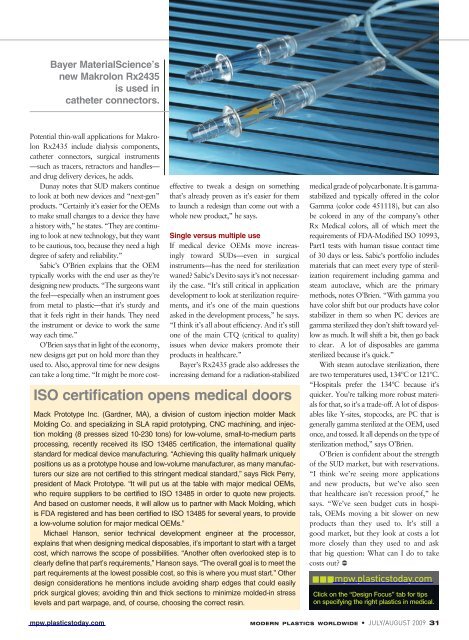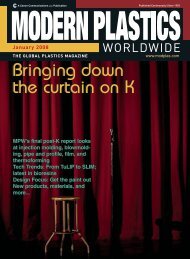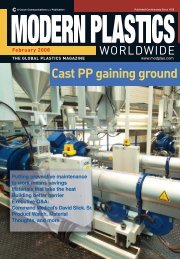Modern Plastics Worldwide - July/August 2009 - dae uptlax
Modern Plastics Worldwide - July/August 2009 - dae uptlax
Modern Plastics Worldwide - July/August 2009 - dae uptlax
You also want an ePaper? Increase the reach of your titles
YUMPU automatically turns print PDFs into web optimized ePapers that Google loves.
Bayer MaterialScience’s<br />
new Makrolon Rx2435<br />
is used in<br />
catheter connectors.<br />
Potential thin-wall applications for Makrolon<br />
Rx2435 include dialysis components,<br />
catheter connectors, surgical instruments<br />
—such as tracers, retractors and handles—<br />
and drug delivery devices, he adds.<br />
Dunay notes that SUD makers continue<br />
to look at both new devices and “next-gen”<br />
products. “Certainly it’s easier for the OEMs<br />
to make small changes to a device they have<br />
a history with,” he states. “They are continuing<br />
to look at new technology, but they want<br />
to be cautious, too, because they need a high<br />
degree of safety and reliability.”<br />
Sabic’s O’Brien explains that the OEM<br />
typically works with the end user as they’re<br />
designing new products. “The surgeons want<br />
the feel—especially when an instrument goes<br />
from metal to plastic—that it’s sturdy and<br />
that it feels right in their hands. They need<br />
the instrument or device to work the same<br />
way each time.”<br />
O’Brien says that in light of the economy,<br />
new designs get put on hold more than they<br />
used to. Also, approval time for new designs<br />
can take a long time. “It might be more cost-<br />
mpw.plasticstoday.com<br />
effective to tweak a design on something<br />
that’s already proven as it’s easier for them<br />
to launch a redesign than come out with a<br />
whole new product,” he says.<br />
Single versus multiple use<br />
If medical device OEMs move increasingly<br />
toward SUDs—even in surgical<br />
instruments—has the need for sterilization<br />
waned? Sabic’s Devito says it’s not necessarily<br />
the case. “It’s still critical in application<br />
development to look at sterilization requirements,<br />
and it’s one of the main questions<br />
asked in the development process,” he says.<br />
“I think it’s all about efficiency. And it’s still<br />
one of the main CTQ (critical to quality)<br />
issues when device makers promote their<br />
products in healthcare.”<br />
Bayer’s Rx2435 grade also addresses the<br />
increasing demand for a radiation-stabilized<br />
ISO certifi cation opens medical doors<br />
Mack Prototype Inc. (Gardner, MA), a division of custom injection molder Mack<br />
Molding Co. and specializing in SLA rapid prototyping, CNC machining, and injection<br />
molding (8 presses sized 10-230 tons) for low-volume, small-to-medium parts<br />
processing, recently received its ISO 13485 certifi cation, the international quality<br />
standard for medical device manufacturing. “Achieving this quality hallmark uniquely<br />
positions us as a prototype house and low-volume manufacturer, as many manufacturers<br />
our size are not certifi ed to this stringent medical standard,” says Rick Perry,<br />
president of Mack Prototype. “It will put us at the table with major medical OEMs,<br />
who require suppliers to be certifi ed to ISO 13485 in order to quote new projects.<br />
And based on customer needs, it will allow us to partner with Mack Molding, which<br />
is FDA registered and has been certifi ed to ISO 13485 for several years, to provide<br />
a low-volume solution for major medical OEMs.”<br />
Michael Hanson, senior technical development engineer at the processor,<br />
explains that when designing medical disposables, it’s important to start with a target<br />
cost, which narrows the scope of possibilities. “Another often overlooked step is to<br />
clearly defi ne that part’s requirements,” Hanson says. “The overall goal is to meet the<br />
part requirements at the lowest possible cost, so this is where you must start.” Other<br />
design considerations he mentions include avoiding sharp edges that could easily<br />
prick surgical gloves; avoiding thin and thick sections to minimize molded-in stress<br />
levels and part warpage, and, of course, choosing the correct resin.<br />
medical grade of polycarbonate. It is gammastabilized<br />
and typically offered in the color<br />
Gamma (color code 451118), but can also<br />
be colored in any of the company’s other<br />
Rx Medical colors, all of which meet the<br />
requirements of FDA-Modified ISO 10993,<br />
Part1 tests with human tissue contact time<br />
of 30 days or less. Sabic’s portfolio includes<br />
materials that can meet every type of sterilization<br />
requirement including gamma and<br />
steam autoclave, which are the primary<br />
methods, notes O’Brien. “With gamma you<br />
have color shift but our products have color<br />
stabilizer in them so when PC devices are<br />
gamma sterilized they don’t shift toward yellow<br />
as much. It will shift a bit, then go back<br />
to clear. A lot of disposables are gamma<br />
sterilized because it’s quick.”<br />
With steam autoclave sterilization, there<br />
are two temperatures used, 134ºC or 121ºC.<br />
“Hospitals prefer the 134ºC because it’s<br />
quicker. You’re talking more robust materials<br />
for that, so it’s a trade-off. A lot of disposables<br />
like Y-sites, stopcocks, are PC that is<br />
generally gamma sterilized at the OEM, used<br />
once, and tossed. It all depends on the type of<br />
sterilization method,” says O’Brien.<br />
O’Brien is confident about the strength<br />
of the SUD market, but with reservations.<br />
“I think we’re seeing more applications<br />
and new products, but we’ve also seen<br />
that healthcare isn’t recession proof,” he<br />
says. “We’ve seen budget cuts in hospitals,<br />
OEMs moving a bit slower on new<br />
products than they used to. It’s still a<br />
good market, but they look at costs a lot<br />
more closely than they used to and ask<br />
that big question: What can I do to take<br />
costs out? MPW<br />
mpw.plasticstoday.com<br />
Click on the “Design Focus” tab for tips<br />
on specifying the right plastics in medical.<br />
MODERN PLASTICS WORLDWIDE • JULY/AUGUST <strong>2009</strong> 31









